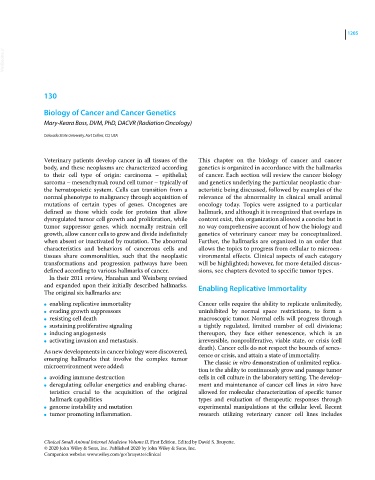Page 1267 - Clinical Small Animal Internal Medicine
P. 1267
1205
VetBooks.ir
130
Biology of Cancer and Cancer Genetics
Mary‐Keara Boss, DVM, PhD, DACVR (Radiation Oncology)
Colorado State University, Fort Collins, CO, USA
Veterinary patients develop cancer in all tissues of the This chapter on the biology of cancer and cancer
body, and these neoplasms are characterized according genetics is organized in accordance with the hallmarks
to their cell type of origin: carcinoma – epithelial; of cancer. Each section will review the cancer biology
sarcoma – mesenchymal; round cell tumor – typically of and genetics underlying the particular neoplastic char-
the hematopoietic system. Cells can transition from a acteristic being discussed, followed by examples of the
normal phenotype to malignancy through acquisition of relevance of the abnormality in clinical small animal
mutations of certain types of genes. Oncogenes are oncology today. Topics were assigned to a particular
defined as those which code for proteins that allow hallmark, and although it is recognized that overlaps in
dysregulated tumor cell growth and proliferation, while content exist, this organization allowed a concise but in
tumor suppressor genes, which normally restrain cell no way comprehensive account of how the biology and
growth, allow cancer cells to grow and divide indefinitely genetics of veterinary cancer may be conceptualized.
when absent or inactivated by mutation. The abnormal Further, the hallmarks are organized in an order that
characteristics and behaviors of cancerous cells and allows the topics to progress from cellular to microen-
tissues share commonalities, such that the neoplastic vironmental effects. Clinical aspects of each category
transformations and progression pathways have been will be highlighted; however, for more detailed discus-
defined according to various hallmarks of cancer. sions, see chapters devoted to specific tumor types.
In their 2011 review, Hanahan and Weinberg revised
and expanded upon their initially described hallmarks. Enabling Replicative Immortality
The original six hallmarks are:
● enabling replicative immortality Cancer cells require the ability to replicate unlimitedly,
● evading growth suppressors uninhibited by normal space restrictions, to form a
● resisting cell death macroscopic tumor. Normal cells will progress through
● sustaining proliferative signaling a tightly regulated, limited number of cell divisions;
● inducing angiogenesis thereupon, they face either senescence, which is an
● activating invasion and metastasis. irreversible, nonproliferative, viable state, or crisis (cell
death). Cancer cells do not respect the bounds of senes-
As new developments in cancer biology were discovered, cence or crisis, and attain a state of immortality.
emerging hallmarks that involve the complex tumor The classic in vitro demonstration of unlimited replica-
microenvironment were added:
tion is the ability to continuously grow and passage tumor
● avoiding immune destruction cells in cell culture in the laboratory setting. The develop-
● deregulating cellular energetics and enabling charac- ment and maintenance of cancer cell lines in vitro have
teristics crucial to the acquisition of the original allowed for molecular characterization of specific tumor
hallmark capabilities types and evaluation of therapeutic responses through
● genome instability and mutation experimental manipulations at the cellular level. Recent
● tumor promoting inflammation. research utilizing veterinary cancer cell lines includes
Clinical Small Animal Internal Medicine Volume II, First Edition. Edited by David S. Bruyette.
© 2020 John Wiley & Sons, Inc. Published 2020 by John Wiley & Sons, Inc.
Companion website: www.wiley.com/go/bruyette/clinical

